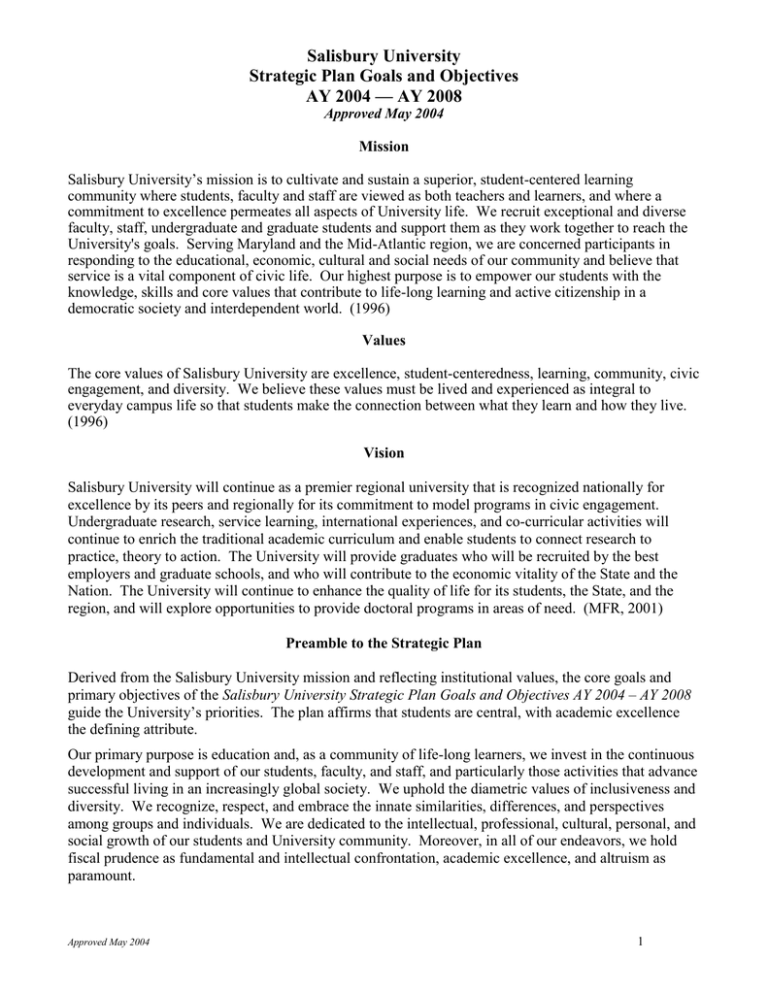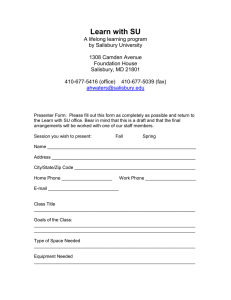Salisbury University Strategic Plan Goals and Objectives AY 2004 — AY 2008
advertisement

Salisbury University Strategic Plan Goals and Objectives AY 2004 — AY 2008 Approved May 2004 Mission Salisbury University’s mission is to cultivate and sustain a superior, student-centered learning community where students, faculty and staff are viewed as both teachers and learners, and where a commitment to excellence permeates all aspects of University life. We recruit exceptional and diverse faculty, staff, undergraduate and graduate students and support them as they work together to reach the University's goals. Serving Maryland and the Mid-Atlantic region, we are concerned participants in responding to the educational, economic, cultural and social needs of our community and believe that service is a vital component of civic life. Our highest purpose is to empower our students with the knowledge, skills and core values that contribute to life-long learning and active citizenship in a democratic society and interdependent world. (1996) Values The core values of Salisbury University are excellence, student-centeredness, learning, community, civic engagement, and diversity. We believe these values must be lived and experienced as integral to everyday campus life so that students make the connection between what they learn and how they live. (1996) Vision Salisbury University will continue as a premier regional university that is recognized nationally for excellence by its peers and regionally for its commitment to model programs in civic engagement. Undergraduate research, service learning, international experiences, and co-curricular activities will continue to enrich the traditional academic curriculum and enable students to connect research to practice, theory to action. The University will provide graduates who will be recruited by the best employers and graduate schools, and who will contribute to the economic vitality of the State and the Nation. The University will continue to enhance the quality of life for its students, the State, and the region, and will explore opportunities to provide doctoral programs in areas of need. (MFR, 2001) Preamble to the Strategic Plan Derived from the Salisbury University mission and reflecting institutional values, the core goals and primary objectives of the Salisbury University Strategic Plan Goals and Objectives AY 2004 – AY 2008 guide the University’s priorities. The plan affirms that students are central, with academic excellence the defining attribute. Our primary purpose is education and, as a community of life-long learners, we invest in the continuous development and support of our students, faculty, and staff, and particularly those activities that advance successful living in an increasingly global society. We uphold the diametric values of inclusiveness and diversity. We recognize, respect, and embrace the innate similarities, differences, and perspectives among groups and individuals. We are dedicated to the intellectual, professional, cultural, personal, and social growth of our students and University community. Moreover, in all of our endeavors, we hold fiscal prudence as fundamental and intellectual confrontation, academic excellence, and altruism as paramount. Approved May 2004 1 Summary of Objectives for Emphasis in the Salisbury University Strategic Plan Goals and Objectives AY 2004 — AY 2008 Approved May 2004 Goal I: The University will enhance an academic and learning environment that promotes intellectual growth and success. D. Provide resources, including a new facility and an enhanced operating budget, to make the library a focal point of learning, scholarship, interaction, and invention among students, faculty, and staff. G. Recruit and retain highly qualified faculty and staff. G.5. Maintain or improve faculty and staff salaries and benefits to levels that are comparable to AAUP (for faculty) and CUPA (for staff) peers. Goal II: The University will advance a student-centered environment. D.1. Improve recreational, wellness, and fitness services, programs, and facilities. A. Increase the level of funding for need- and merit-based undergraduate and graduate scholarships. G. Develop and implement a more comprehensive orientation program for freshman and transfer students that improves academic and personal transitions and deepens their connections with their peers and the University. Goal III: The University will foster inclusiveness as well as cultural and intellectual pluralism. G. D. C. A. Promote international educational opportunities as a means of broadening life experience and cross-cultural understanding for students and faculty. Enhance and create support programs to increase the retention and graduation rates of those identified student groups whose retention and graduation rates are below those of other groups. Foster the growth of a more diverse student and employee population. Provide multicultural and sensitivity education and activities for the campus community. Goal IV: The University will utilize strategic collaborations and targeted community outreach to benefit the University, Maryland, and the region. H. E. G. F. Approved May 2004 Enhance private and public fundraising for projects and programs that support the academic objectives, capital initiatives, and other priorities identified in the Facilities Master Plan, with particular attention to funding a new library facility. Encourage and support the development of non-credit programs as self-supporting revenue generating sources. Establish and enhance collaborations with the private sector, schools, community, government, and non-government organizations. Recognize and reward students, faculty, and staff involved in (SU) strategic collaborations and targeted community outreach. 2 Salisbury University Strategic Plan Goals and Objectives AY 2004 — AY 2008 Goal I: The University will enhance an academic and learning environment that promotes intellectual growth and success. A. Maintain and advance academic excellence as the defining attribute of all academic programs and student learning. B. Enhance General Education as the necessary foundational experience for students. C. Offer each student opportunities for experiential learning, including but not limited to: service learning; civic engagement; volunteering; internships; student research; study abroad; and community outreach activities. D. Provide resources, including a new facility and an enhanced operating budget, to make the library a focal point of learning, scholarship, interaction, and invention among students, faculty, and staff. E. Ensure resources support and strengthen current academic programs, while exploring opportunities to offer new graduate and undergraduate programs. F. Promote student technology fluency, as well as relevant faculty and staff development in the use of technology in teaching and services. 1. G. Approved May 2004 Provide effective and reliable classroom and computer lab technology and campus telecommunications infrastructure. Recruit and retain highly qualified faculty and staff. 1. Develop and implement workload standards that are comparable to institutional peers. 2. Develop and implement mechanisms for enhancing faculty and staff rewards and support. 3. Strengthen available resources for scholarship, research, sabbatical leaves, professional activities, and other faculty development opportunities. 4. Maintain the commitment to having the vast majority of instructional staff consist of tenured and tenure-track faculty, and strive to provide healthcare, pension, and other benefits to all full-time faculty and staff. 5. Maintain or improve faculty and staff salaries and benefits to levels that are comparable to AAUP (for faculty) and CUPA (for staff) peers. 3 Goal II: The University will advance a student-centered environment. A. Increase the level of funding for need- and merit-based undergraduate and graduate scholarships. B. Develop “Student Academic Enrichment Centers” to assist the academic achievement of students of all abilities. C. Maintain and improve the high quality of advising, individualized for undergraduates and graduates. D. 1. Establish faculty/advisee ratios at levels consistent with BOR policies and school guidelines. 2. Ensure that a full-time advising coordinator is on staff in all schools. Elevate student access to campus services and activities. 1. Improve recreational, wellness, and fitness services, programs, and facilities. 2. Examine and implement alternative scheduling options and support services to meet the needs of our students. E. Sustain quality theatre, leadership, Division III Athletics, and other extracurricular programming while affirming academics as the highest priority in the lives of students. F. Provide classrooms and other settings that foster effective faculty-student connections and engaged, interactive student learning, and strengthens student to faculty exchanges. G. Develop and implement a more comprehensive orientation program for freshman and transfer students that improves academic and personal transitions and deepens their connections with their peers and the University. Approved May 2004 4 Goal III: The University will foster inclusiveness as well as cultural and intellectual pluralism. A. Provide multicultural and sensitivity education and activities for the campus community. B. Examine and align the weight of the current, multiple admissions factors, particularly standardized tests, in line with institutional priorities and values. C. Foster the growth of a more diverse student and employee population. D. Enhance and create support programs to increase the retention and graduation rates of those identified student groups whose retention and graduation rates are below those of other groups. E. Expand academic and social practices/support for the integration of international students into SU and the local community. F. Enhance SU linkages to immigrant communities. G. Promote international educational opportunities as a means of broadening life experience and cross-cultural understanding for students and faculty. H. Enhance “multiculturalism” throughout the curriculum. I. Work cooperatively with K-12 institutions and community colleges to enhance the success of underrepresented groups. Approved May 2004 5 Goal IV: The University will utilize strategic collaborations and targeted community outreach to benefit the University, Maryland, and the region. A. Align SU strategic collaborations and targeted community outreach activities with institutional priorities. B. Enhance the University’s ability to respond to the region’s business, economic, community, and workforce development needs through its academic and extra-curricular activities. C. Develop and implement an effective, efficient, integrated, comprehensive University marketing plan. D. Encourage and support the development of grant and sponsored research projects and programs that support the University’s mission. E. Encourage and support the development of non-credit programs as self-supporting revenue generating sources. F. Recognize and reward students, faculty, and staff involved in (SU) strategic collaborations and targeted community outreach. G. Establish and enhance collaborations with the private sector, schools, community, government, and non-government organizations. H. Enhance private and public fundraising for projects and programs that support the academic objectives, capital initiatives, and other priorities identified in the Facilities Master Plan, with particular attention to funding a new library facility. Approved May 2004 6
